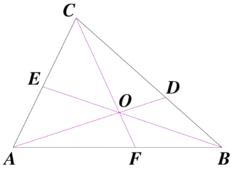Cevian
In geometry, a cevian is a line that intersects both a triangle's vertex, and also the side that is opposite to that vertex.[1][2] Medians and angle bisectors are special cases of cevians. The name "cevian" comes from the Italian mathematician Giovanni Ceva, who proved a well-known theorem about cevians which also bears his name.[3]
Length

Stewart's theorem
The length of a cevian can be determined by Stewart's theorem: in the diagram, the cevian length d is given by the formula
or, less commonly,
Median
If the cevian happens to be a median (thus bisecting a side), its length can be determined from the formula
or
since
Hence in this case
Angle bisector
If the cevian happens to be an angle bisector, its length obeys the formulas
and[5]
and
where the semiperimeter s = (a+b+c)/2.
The side of length a is divided in the proportion b:c.
Altitude
If the cevian happens to be an altitude and thus perpendicular to a side, its length obeys the formulas
and
where the semiperimeter s = (a+b+c) / 2.
Ratio properties

There are various properties of the ratios of lengths formed by three cevians all passing through the same arbitrary interior point:[6]:177-188 Referring to the diagram at right,
These last two properties are equivalent because summing the two equations gives the identity 1 + 1 + 1 = 3.
Splitter
A splitter of a triangle is a cevian that bisects the perimeter. The three splitters concur at the Nagel point of the triangle.
Area bisectors
Three of the area bisectors of a triangle are its medians, which connect the vertices to the opposite side midpoints. Thus a uniform-density triangle would in principle balance on a razor supporting any of the medians.
Angle trisectors
If from each vertex of a triangle two cevians are drawn so as to trisect the angle (divide it into three equal angles), then the six cevians intersect in pairs to form an equilateral triangle, called the Morley triangle.
Area of inner triangle formed by cevians
Routh's theorem determines the ratio of the area of a given triangle to that of a triangle formed by the pairwise intersections of three cevians, one from each vertex.
See also
- Mass point geometry
- Menelaus' theorem
Notes
- ↑ Coxeter, H. S. M.; Greitzer, S. L. (1967). Geometry Revisited. Washington, DC: Mathematical Association of America. p. 4. ISBN 0-883-85619-0. https://archive.org/details/geometryrevisite00coxe.
- ↑ Some authors exclude the other two sides of the triangle, see (Eves 1963)
- ↑ Lightner, James E. (1975). "A new look at the 'centers' of a triangle". The Mathematics Teacher 68 (7): 612–615.
- ↑ "Art of Problem Solving". https://artofproblemsolving.com/wiki/index.php?title=Stewart's_Theorem.
- ↑ Johnson, Roger A., Advanced Euclidean Geometry, Dover Publ., 2007 (orig. 1929), p. 70.
- ↑ Alfred S. Posamentier and Charles T. Salkind, Challenging Problems in Geometry, Dover Publishing Co., second revised edition, 1996.
References
- Eves, Howard (1963), A Survey of Geometry (Vol. One), Allyn and Bacon
- Ross Honsberger (1995). Episodes in Nineteenth and Twentieth Century Euclidean Geometry, pages 13 and 137. Mathematical Association of America.
- Vladimir Karapetoff (1929). "Some properties of correlative vertex lines in a plane triangle." American Mathematical Monthly 36: 476–479.
- Indika Shameera Amarasinghe (2011). “A New Theorem on any Right-angled Cevian Triangle.” Journal of the World Federation of National Mathematics Competitions, Vol 24 (02), pp. 29–37.

